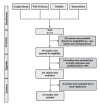Childhood Obesity: A Narrative Review
- PMID: 40231296
- PMCID: PMC11995813
- DOI: 10.7759/cureus.82233
Childhood Obesity: A Narrative Review
Abstract
Obesity among children has emerged as a worldwide health issue due to childhood obesity becoming a pandemic, and it is often linked to various illnesses, fatal outcomes, and disability in adulthood. Obesity has become an epidemic issue in both developed and developing countries, particularly among youngsters. The most common factors contributing to non-communicable diseases (NCDs) are unhealthy eating habits, desk-bound games, avoidance of physical activity-requiring activities, smoking, alcohol usage, and other added items. All these factors increase NCDs, including obesity, resulting in various morbidities and early death. Additionally, childhood obesity has psychological, emotional, cognitive, societal, and communicative effects. For example, it raises the possibility of issues related to physical appearance, self-esteem, confidence level, feelings of isolation, social disengagement, stigma, depression, and a sense of inequality. Children who consume more energy-dense, high-fat, low-fiber-containing food than they need usually store the excess as body fat. Standardizing indicators and terminology for obesity-related metrics is critical for better understanding the comparability of obesity prevalence and program effectiveness within and between countries. The underlying variables must be altered to reduce or avoid harm to the target organ in children. As a result, reducing childhood obesity is a considerable public health goal for the benefit of society and the long-term well-being of individuals.
Keywords: childhood obesity; heart disease; insulin resistance; low-income countries; metabolic syndrome; obesity; physical activity; psychosocial health; public health; stress.
Copyright © 2025, Sinha et al.
Conflict of interest statement
Conflicts of interest: In compliance with the ICMJE uniform disclosure form, all authors declare the following: Payment/services info: All authors have declared that no financial support was received from any organization for the submitted work. Financial relationships: All authors have declared that they have no financial relationships at present or within the previous three years with any organizations that might have an interest in the submitted work. Other relationships: All authors have declared that there are no other relationships or activities that could appear to have influenced the submitted work.
Figures




References
-
- In-patient outcomes of patients with diabetic ketoacidosis and concurrent protein energy malnutrition: a national database study from 2016 to 2017. Kichloo A, Shaka H, El-Amir Z, et al. Postgrad Med. 2021;133:854–859. - PubMed
-
- Changing dietary patterns is necessary to improve the sustainability of Western diets from a One Health perspective. Paris JM, Falkenberg T, Nöthlings U, Heinzel C, Borgemeister C, Escobar N. Sci Total Environ. 2022;811:151437. - PubMed
Publication types
LinkOut - more resources
Full Text Sources
Research Materials
